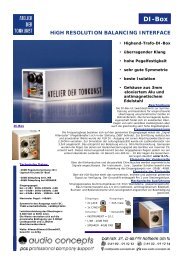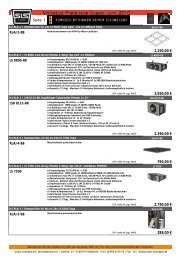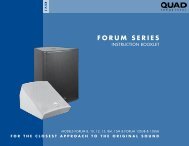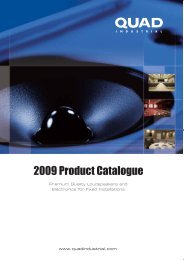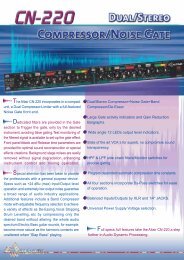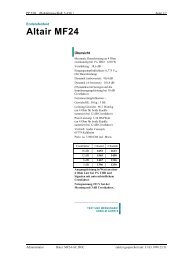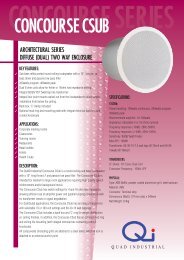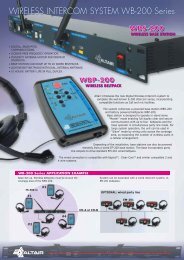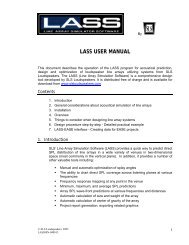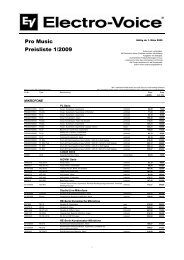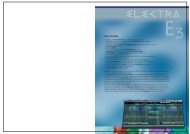C6TRM + C6 C6TRM + C6 C6TRM + C6 - audio concepts
C6TRM + C6 C6TRM + C6 C6TRM + C6 - audio concepts
C6TRM + C6 C6TRM + C6 C6TRM + C6 - audio concepts
You also want an ePaper? Increase the reach of your titles
YUMPU automatically turns print PDFs into web optimized ePapers that Google loves.
Installation hint<br />
Connection<br />
CORNORED top-boxes are available with either XLR/Speakon plugs or barrier<br />
strip terminals:<br />
a. The Speakon version is recommended when the product is used in a non-<br />
fixed installation such as low-level stage monitoring, broadcast, etc.<br />
b. The XLR version is recommended in applications where the speaker cable<br />
is located externally on the wall or ceiling. Being smaller and more elegant<br />
than the Speakon plug, the XLR connector will become part of the design<br />
when mounted into the cabinet.<br />
c. The barrier strip terminal is recommended in applications where the cable<br />
is hidden inside the wall or ceiling and emerges directly behind the speaker<br />
cabinet. In this application there are no visible speaker terminals when the<br />
speaker is installed.<br />
Connect a Speakon plug<br />
The Speakon pin configuration is standard. Plus (+) is connected to 1+ in the<br />
Speakon socket and minus (–) is connected to 1- in the Speakon socket. Simply<br />
insert the plug and turn it to the right until you hear or feel it click into the<br />
Speakon socket. To remove the Speakon connector, pull back the metal bar,<br />
turn the plug to the left and pull it out.<br />
The XLR pin configuration is standard. Plus (+) is connected to 2 in the XLR<br />
socket and minus (–) is connected to 1 in the XLR socket. Simply insert the<br />
XLR connector into the XLR socket until you hear or feel it click. To remove the<br />
XLR connector, push the metal bar on the socket down and pull out the XLR<br />
connector.<br />
If the corner is more than 90 degree or if cables or lists takesup space<br />
behind the cabinet, not allowing it to come flush with wall or ceiling,<br />
simply leave some space between the speaker cabinet and either wall or ceiling<br />
by placing a small washer.<br />
Connect an XLR plug<br />
Connect to the barrier strip terminal<br />
The barrier strip terminal will accept bare wire or a U-type cable shoe (ill. x).<br />
To ensure correct polarity, make sure that + (red) on the amplifier output is<br />
connected to + on the barrier strip terminal and that – (black) on the amplifier<br />
output is connected to – on the barrier strip terminal.<br />
Recommended speaker cables<br />
Speaker cables present the amplifier with different loads. Cables with high<br />
capacitance, high inductance and high impedance have a strong negative influ-<br />
ence on sound quality as well as amplifier reliability, so in order to get the most<br />
out of the speaker system, avoid using thin speaker cables.<br />
As a rule of thumb, 2 mm2 (14 AWG) cable can be used for lengths up to 20<br />
meters. 4 mm2 (11 AWG) cable should be used for lengths over 20 meters. For<br />
lengths over 50 meters, most amplifiers will become unstable and sound qual-<br />
ity is reduced significantly.<br />
Safety wire<br />
In installation terms, the CORNORED top-boxes are ‘as much brackets as they<br />
are speakers,’ so no safety wire is needed, just as you wouldn’t need a safety<br />
wire from the wall to a bracket. However, if required, simply attach the wire to<br />
one of the top plate screws.<br />
Warranty<br />
For warranty information, please refer to your local CORNORED distributor or<br />
dealer.<br />
Service<br />
Spare parts for your CORNORED speakers are available through your local<br />
CORNORED distributor. In case you are not able to source spare parts locally,<br />
please contact us directly at info@CORNORED.com.



